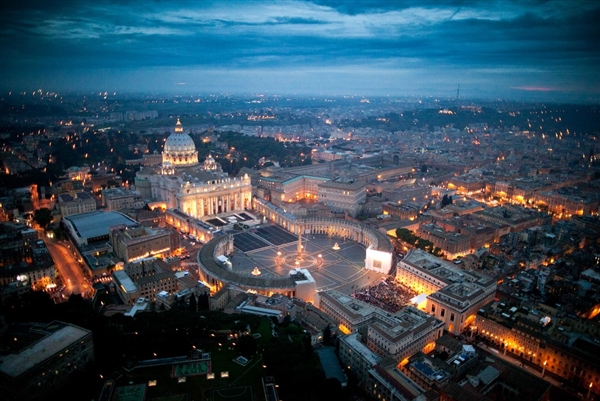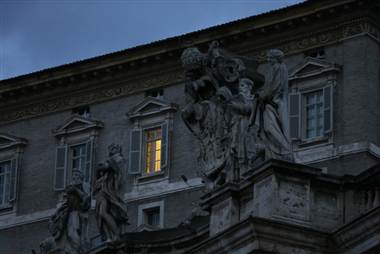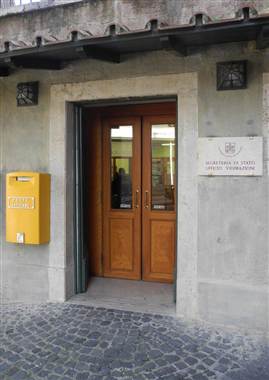Inside the Vatican: the $8 Billion Global Institution Where Nuns Answer the Phones
By Alastair Jamieson
As the Catholic church prepares to choose its second leader in a decade, the world’s eyes are once again focused on the complex and secretive ways of the Vatican. In mid-March, 117 cardinals will be locked inside its walls until they decide who should next attempt to govern one of humankind’s most enduring, yet bewildering, institutions. Their new pope must not only provide spiritual leadership to followers in more than 180 countries around the globe, but also reconcile deep divisions within the two-and-a-half square miles of the Vatican itself, on the left bank of Rome’s Tiber river. In his homily at Mass late Wednesday, Pope Benedict XVI spoke of “sins against the unity of the Church,” hinting at the office politics of an organization worth at least $8 billion but which features a switchboard operated by nuns. As the Catholic church prepares to choose its second leader in a decade, the world’s eyes are once again focused on the complex and secretive ways of the Vatican. In mid-March, 117 cardinals will be locked inside its walls until they decide who should next attempt to govern one of humankind’s most enduring, yet bewildering, institutions. Their new pope must not only provide spiritual leadership to followers in more than 180 countries around the globe, but also reconcile deep divisions within the two-and-a-half square miles of the Vatican itself, on the left bank of Rome’s Tiber river. In his homily at Mass late Wednesday, Pope Benedict XVI spoke of “sins against the unity of the Church,” hinting at the office politics of an organization worth at least $8 billion but which features a switchboard operated by nuns.
“When the main elevator of the Apostolic Palace stops at the third floor, you have two choices: turning to the left, for the pope's private apartment, or to the right, for the offices of the Secretariat of the State,” he wrote in a 1997 article for ‘The Catholic Answer’. “Every day about 200 men and women - bishops, priests, religious and laity- turn to the right. They walk along magnificently frescoed corridors to their modest offices, where they discretely collaborate in the pope's ministry to the Church and the world.” Although the wealth of the church has been on display throughout history, its financial details are not. Paolo Cipriani - director of The Institute for Works of Religion (IOR), often referred to as the ‘Vatican Bank’ - last year pledged to “lift the veil of secrecy” surrounding the organization. The institute manages $8 billion of the church’s worldwide wealth and investments as well as 33,000 accounts for clergy and parishes, held in euros. An open day last June was the first occasion in which journalists had been allowed inside its headquarters, inside a medieval defensive tower that once housed the Vatican prisons, newspaper La Stampa reported. 'A pretty lean organization' It is an environment at once opulent and modest. Despite the vast assets of the Church, the Holy See made a loss of $18.4 million loss in 2011. Its $308 million income from IOR revenues - and supporters including its biggest single donor, the United States – exceeded the $326.4 million cost of running its global missions and operations such as Vatican Radio. A separate budget for the Vatican City state, which deals with the administration of the church’s "home" in Rome made a $12.4 million profit in 2011, with most of its $113 million coming from tourists at its museums. “This Dan Brown notion that the church is oozing millions of euros is just not true,” Weigel said. “These incredible buildings are not liquid assets. Most of the money that comes into the church goes straight back out again. “When the main elevator of the Apostolic Palace stops at the third floor, you have two choices: turning to the left, for the pope's private apartment, or to the right, for the offices of the Secretariat of the State,” he wrote in a 1997 article for ‘The Catholic Answer’. “Every day about 200 men and women - bishops, priests, religious and laity- turn to the right. They walk along magnificently frescoed corridors to their modest offices, where they discretely collaborate in the pope's ministry to the Church and the world.” Although the wealth of the church has been on display throughout history, its financial details are not. Paolo Cipriani - director of The Institute for Works of Religion (IOR), often referred to as the ‘Vatican Bank’ - last year pledged to “lift the veil of secrecy” surrounding the organization. The institute manages $8 billion of the church’s worldwide wealth and investments as well as 33,000 accounts for clergy and parishes, held in euros. An open day last June was the first occasion in which journalists had been allowed inside its headquarters, inside a medieval defensive tower that once housed the Vatican prisons, newspaper La Stampa reported. 'A pretty lean organization' It is an environment at once opulent and modest. Despite the vast assets of the Church, the Holy See made a loss of $18.4 million loss in 2011. Its $308 million income from IOR revenues - and supporters including its biggest single donor, the United States – exceeded the $326.4 million cost of running its global missions and operations such as Vatican Radio. A separate budget for the Vatican City state, which deals with the administration of the church’s "home" in Rome made a $12.4 million profit in 2011, with most of its $113 million coming from tourists at its museums. “This Dan Brown notion that the church is oozing millions of euros is just not true,” Weigel said. “These incredible buildings are not liquid assets. Most of the money that comes into the church goes straight back out again.
Even the more secular aspects of the Vatican, the city state, are complex thanks to its geography. Squeezed into a triangular site in central Rome, the smallest country in the world has grown well outside its original footprint and much of its buildings and offices – including its own hospital – lie outside its boundaries but are granted the same judicial separation from the rest of Italy. Much of the administration of the Vatican City, which issues its own passports and license plates and has its own postal service – reportedly much more efficient than its Italian counterpart – is carried out by lay workers who must agree to the church’s moral instruction. “I don’t think they have to be Catholic but I would image that, this being Italy and because of the nature of the job, most people who apply are Catholic,” Gahl said. “I would also think that, when you interview somebody for a job at any non-profit you are likely to choose somebody who shares the same ideals and objectives as the organization.” One of the first tasks of the new pope will be to try and rein in the Roman Curia - the Byzantine hierarchy of the Holy See, which includes various dicasteries, pontifical councils and secretariats - as well as modernize its practices. “There is a feeling that Benedict never really got to grips with it at all,” said Weigel. “I think some changes are going to essential for the new pope.” A dissident Austrian priest, Rev. Helmut Schueller, has spoken out against the ritual of the cardinals' conclave - at which voting papers in the ballot for the new pope are burned to create white smoke - and called for greater openness in the process of selecting a new leader. "If things were going well, the conclave fathers would at least be going out to the Church grassroots and calling meetings to really hear what the faithful expect," he told Reuters on Wednesday. However, running the Vatican will require more than just fresh management skills. “The pope is not so much the head of a corporation, more the CEO of a large non-profit – and that means bringing clarity in direction and teaching,” said Gahl. “Cardinals do not usually subscribe to Harvard Business Review.”
|
.
Any original material on these pages is copyright © BishopAccountability.org 2004. Reproduce freely with attribution.


